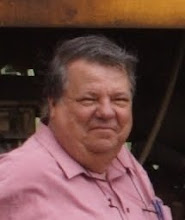I have built layouts before and worked on many club layouts but that was many years ago. That was in HO while this layout is O Scale. Clearances had to be right as we did not want to have the same problems we had with the garage layout where we had to pull up and relay sections because of the lack of clearances near pointwork.
I had purchased a pack of cork tiles at Bunnings with the intention of cutting these up to use as ballast underlay but we decided not to go with that. I now cut the tiles to act as spacers so as to get the track centres right and to ensure tracks were straight. We found it was very difficult to see a centre line drawn in pencil on the baseboard as with the 54 inch height of the baseboard we could not easily get above the track to ensure the track was centred on these lines. Using the cork as a spacer made the task somewhat easier.
Work continued on this first section through the station yard on Monday night making sure the track was straight as it was spiked down.
Raymond took the day off on Tuesday with the intention of getting us much track laid as possible, the installation of point motors and wiring to allow something to run.
I arrived home at 4:00 pm on Tuesday ready to help Raymond clean up and get ready for Mackie’s Marauders who would be arriving at about 7:15 pm. I found Raymond sitting on the back steps looking rather dejected. He said he had struck some problems and had not progressed as far as he would have liked.
Raymond listed a litany of problems which he had found so frustrating. Installing the Cobalt point motors was OK where he could get at them from under the layout but the three points in a row at the left-hand end of the station loops were directly over a 4 X 1 timber L-Girder which was lying with the 4 inch side laying directly under where the point motors were to go. This did not allow him to get the Phillips Head screwdriver in to fix the motor in place although there was plenty of clearance for the point motor. The heads of the screwdrivers we had were also badly worn and did not easily work with the small headed screws. The Template we had used had located the actuator arm OK but the pilot holes to mount the Cobalt motors did not match. This was not found to be a major problem as the screws were self-tapping and could be screwed into the baseboard relatively easily where he could get at the screw locations. The wiring had also been an issue as there were no drill bits available to give a large enough hole for freedom of movement.
I tried to cheer him up saying one of the Marauders would be able to supply a solution.
We vacuumed the shed and got the supper ready and the tea urn on for hot water.
The guys started rolling in at 7:15 pm and all were pleased that we had made at least some progress. We had a good turnout with eleven present (including ourselves). It was especially pleasing to welcome PeterH from the Sunshine Coast. Peter used to live in the same suburb as but he and his wife opted for a “sea change” some years ago.
As I had predicted at least two of the Marauders came up with a solution (the same in fact) for the fixing of the point motors above the 4 X 1 L-girder.
 Mackie's Marauders chatting about their latest modelling efforts
Mackie's Marauders chatting about their latest modelling effortsWe had our usual gab fest with the Marauders exchanging ideas and talking about their latest progress about various projects. MikeB is one a senior member of the group and one of the most prolific scratch-builders. He seems to have a keen eye to turn a piece of junk or bits and pieces into an eye-catching model. Raymond and I would like to thank MikeB as he presented us with one of his scratch built models to decorate the scenery on our new layout.
 The derelict farm shed scratch-built by MikeB and presented to us on Tuesday night for our layout.
The derelict farm shed scratch-built by MikeB and presented to us on Tuesday night for our layout.We spent a pleasant evening looking at the latest journals with our copies of Narrow Gauge & Shortline Gazette, 7 mm Scale Journal; On30 Annual 2011 and Narrow Gauge and Industrial Railway Modelling Review available for the guys to look at. We are hoping to turn them to the “Dark Side” modelling On30 narrow gauge instead of that HO Scale New South Wales “stuff”.
Later in the week I purchased a 25 mm and 18 mm spade bits and a couple of Phillips Head screwdrivers on my way home from work.






